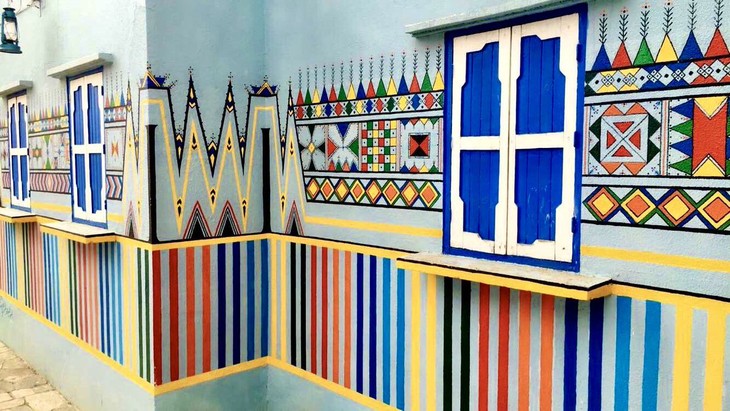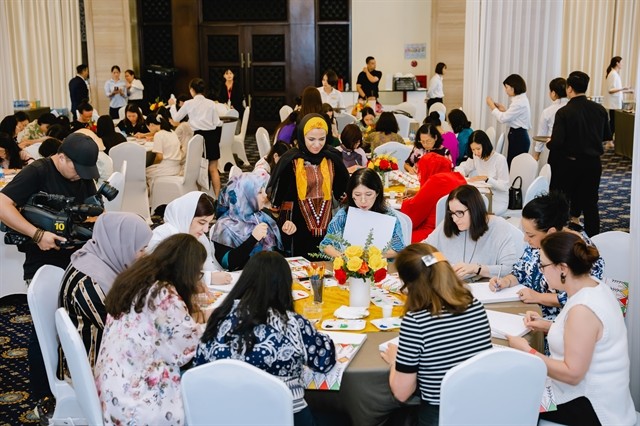Dr. Mahros told her guests at last month’s gathering the Al-Qatt Al-Asiri is important because it's an ancient heritage with a long life, more than 200 or 300 years.
“They know this because there is a background behind every detail in these patterns. Every detail means something religious or feminine or about happiness. They express their feelings in these drawings,” said Dr. Hiba.
Al-Qatt Al-Asiri is considered “female” interior wall decoration because traditionally men take care of the exterior of the home and women take care of the interior.
“In the past, the man assumed responsibility for building and maintaining the house from the outside and the woman of the house decorated the interior walls, where she drew harmonious shapes with bright, attractive colours,” according to Dr. Hiba.
While historically practiced by women, contemporary male and female artists, architects, and interior designers alike now draw Al-Qatt patterns on walls, garments, women's accessories, and furniture.
Al-Qatt is known for its rich aesthetic and plastic values and is part of the identity of the Asir region. Local women used it to decorate the interior walls of their houses, particularly the living room.
Dr. Hiba recalls, “Housewives draw without any preliminary sketch, without any planning, just randomly and without difficulty. They used to extract the colors from natural resources. Nowadays there is acrylic color and no one still uses natural resources because synthetic colors are available.”
 Al-Qatt Al-Asiri was recognized by UNESCO as an Intangible cultural heritage in 2017. Al-Qatt Al-Asiri was recognized by UNESCO as an Intangible cultural heritage in 2017. |
Al-Qatt art consists of geometric shapes and symbols added in layers. Each has its own symbolism and aesthetic and cultural significance, representing people, religion, and elements of the environment.
Dr. Hiba took an equilateral triangle as an example, which symbolizes Al Banat, or girls in English.
“The triangle in the middle is bigger than the triangles beside the middle one. The biggest one is bright and the other triangles are like bridesmaid. The wheat symbolizes food. If you find the end of this pattern, that is Khatamah. That means, in English, the finalization of anything or the end of anything. It's significant in Islam. If you read the Quran, our holy book, completely, we call it Khatamah,” Dr. Hiba explained.
Among the important motifs and details of Al-Qatt art, said Dr. Hiba, the most popular ones are Al Banat, Athwaq, and Amshat.
“Amshat is equal lines. It means that in our society everyone is equal to each other despite their differences. It's like unity for people and community and Banat because it's done by girls. The most common pattern is Al Banat, I guess,” she said.
After creating the outline of shapes, colors are used to complete the design. The talent of the Asiri woman shows in the way they mix primary colors - red, yellow, black, and blue - with secondary colors to express the aesthetics of the Al-Qatt Al-Asiri art.
 The event was attended by various female representatives of Vietnamese ministries and agencies, female Heads of international organizations, Spouses of Ambassadors, Chargé d'affaires in Vietnam, and many female journalists representing media agencies operating in Hanoi. (Photo courtesy of the embassy) The event was attended by various female representatives of Vietnamese ministries and agencies, female Heads of international organizations, Spouses of Ambassadors, Chargé d'affaires in Vietnam, and many female journalists representing media agencies operating in Hanoi. (Photo courtesy of the embassy)
|
In the past, all materials used in this art came from nature and were collected by the women. They used plants, flowers, and soil to create pigments, and goat tails, twigs, and thorns to create painting tools.
A delicate aesthetic sense is instinctive in Saudi women, and particularly Asir women. They start by using a material that is composed of a mix derived from gypsum found in the surrounding mountains and apply it to the walls to create a white surface for working upon.
The black color is made by charcoal. Iron-rich stones crushed and mixed with plant mucilage create the red color. The color blue is extracted from a substance called "indigo" or "indigo dye” which is derived from a plant. Yellow can be obtained from turmeric root while green comes from fresh grass and plants around the village. And from there wonderful paintings are created.
The art is believed to enhance social bonding and solidarity among the community and has a therapeutic effect on its practitioners. The application of the art in most households ensures its viability within the community, and local individuals have created galleries within their houses in order to safeguard it.
Observation and practice are the key methods for transmitting the practice from one generation to the next.